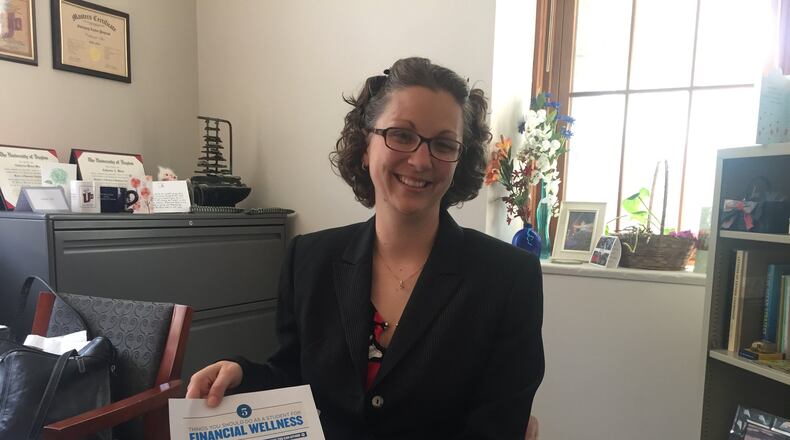Two-thirds of 2015 Ohio grads had loan debt, and the state tied for the eighth-highest average debt with Illinois, New Jersey and Massachusetts.
Amy Barnhart, vice president of enrollment management and director of financial aid at Wright State, wasn’t surprised that WSU came in slightly above the state average at $30,790.
“I wish it were lower, to be frank,” Barnhart said. “We need to have something in place so students do not have to borrow so much.”
UD students graduated with an average of $35,740 in debt in 2015 and Wittenberg grads had an average of $34,178. Officials from both universities said they were not surprised because private schools typically cost more.
Miami University and Cedarville University grads left college slightly less in debt than the average Ohio student.
Barnhart and other college officials said it’s hard to pinpoint the biggest cause for Ohio’s high student debt, but they often point to an increased cost of living, the state’s low investment in higher education and a lack of financial literacy among incoming students.
“It paints a pretty grim picture, but it’s not the whole picture,” Barnhart said.
Extra costs
When students go to college, officials said they do not always recognized all of their costs. UD tries to be upfront about the cost of tuition and extras, said Robert Durkle, associate vice president and dean of admissions and financial aid.
UD offers students a guide to show how much college will cost over four years as opposed to just one, and students will not see a tuition increase in their four years.
Not raising tuition seems to be helping students, said Catherine Mix, UD assistant vice president of financial aid. Current seniors will be the first to graduate at UD under the plan. On average they’re borrowing $5,000 less, Mix said.
“We’re trying to do our part to make that very transparent so that they know coming to the University of Dayton, here’s what you can anticipate,” Durkle said.
Aside from tuition, the cost of living also can hike student debt. Loans are also being used for food, necessities “and the whole nine,” Barnhart said.
“There’s so much to loan debt other than the cost of college,” she said.
State support
Decreases in state funding over several decades could also play a role in student loan debt. The less funding the state provides, the more the financial burden is shifted to students, said Randy Green, director of financial aid at Wittenberg.
Ohio’s per-student spending dropped from $5,627 in 2008 to $5,078 in 2015, according to The Chronicle of Higher Education. The national average in 2015 was $6,996.
Bruce Johnson, president for the Inter-University Council of Ohio, talked about the need for more state funding in higher education during a presidential search symposium at Wright State last week.
“The state has always under-invested in higher education,” Johnson said. “It’s a tragic mistake. We should at least aspire to be like West Virginia and Mississippi.”
When it comes to student financial aid, Ohio spends less than most states. Ohio offers about $120 million in student aid, which is $113.6 million less than the national state average, according to Chronicle data.
Less aid means fewer options for students who can’t cover costs with their own wallet, Barnhart said.
“They have to use loans, that’s the sad part,” Barnhart said.
State Rep. Mike Duffey, R-Worthington, a member of the Attorney General’s student loan debt advisory group, said state leaders are considering several methods to lower college costs.
“We’re throwing a lot against the wall to see what sticks,” Duffey said.
Learn to budget
Students often do not know what they're getting into when they take out school loans. Officials said that's partly why Ohio also has the 10th-highest default rate.
The default rate has college financial aid leaders calling for students to receive more financial education in high school or as they’re applying for aid.
“It amazes me what students don’t know when they get to college,” said Brent Shock, Miami’s assistant vice president of enrollment management and director of financial services. “I think at the high school level some sort of course is needed.”
One-on-one counseling, officials said, is another option, though most schools do not have the resources to offer it. Wittenberg and UD offer individualized, in-person counseling.
“We start off emphasizing that you need to have a plan … we want them to understand that up front,” Mix said.
Other schools typically rely on peer counseling or online financial advising for students. Students who receive federal loans must complete online counseling once.
Miami University identifies students who are incurring high loan debt and offers individual help. Wright State offers debt exit counseling for soon-to-be grads and encourages students to attend personal finance workshops with the chance to win a $1,000 scholarship.
Despite available resources, Barnhart said universities should offer more counseling, especially since it’s expected that the federal government will soon make that a requirement.
“Right now we’re looking at options and there’s not an easy solution by any stretch,” Barnhart said.
About the Author
